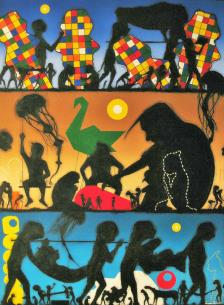After Reading W.S. Merwin’s The Carrier of Ladders
and then finding the Extinct Birds of NZ website.
Tahi.
The first that comes to mind is the Huia,
which Sir Walter Buller said sang like a soft-flute.
The female had a long curved beak,
and the male a short one. A male and female
approached Sir Walter when he whistled,
and as they hopped slowly away his companion
shot them. Their feathers were prized
by chiefs, and long beaks too, for adornments.
Europeans admired the black tail-feathers
tipped with white. The Duke of York was given
a Huia feather when he visited New Zealand in 1902
and inaugurated a European fashion-craze
that most directly led to their extinction.
Rua.
The Moa is held up against Maori
for killing a food resource. We often hear
about moa and Maori in the same breath.
I agree this bird shows our humanity.
Dinornis Robustus stood two metres
at the shoulder, with another metre
to the end of the neck. You've probably
heard that museum assemblies, where
the bird cranes to its full three metres,
are fanciful – that its head was connected
most likely to an S-bend. The small ones
were bigger than a turkey. Many moa
could look a tall person in the eye.
The last ones vanished hundreds of years
ago into Maori stomachs. We're also
critiqued for the disappearances
of the giant eagle, and many other
song birds. Moe mai, moe mai, moe mai rā.
Toru.
The Giant Eagle's wingspan was three metres—
its main food was moa. It was the world’s
largest eagle—the youngest set of bones
found so far is five hundred years old.
Wha.
The Stephens Island Wren was spread throughout
the North and South Island. Its common cousin
is the Rifleman. The only non-Maori
to see one alive was the lighthouse keeper,
David Lyall, of Stephens Island in
1894. His cat fetched seventeen
similar corpses not long after and so
the bird was declared discovered and extinct
at the London ornithologists’ club
meeting held in 1895.

